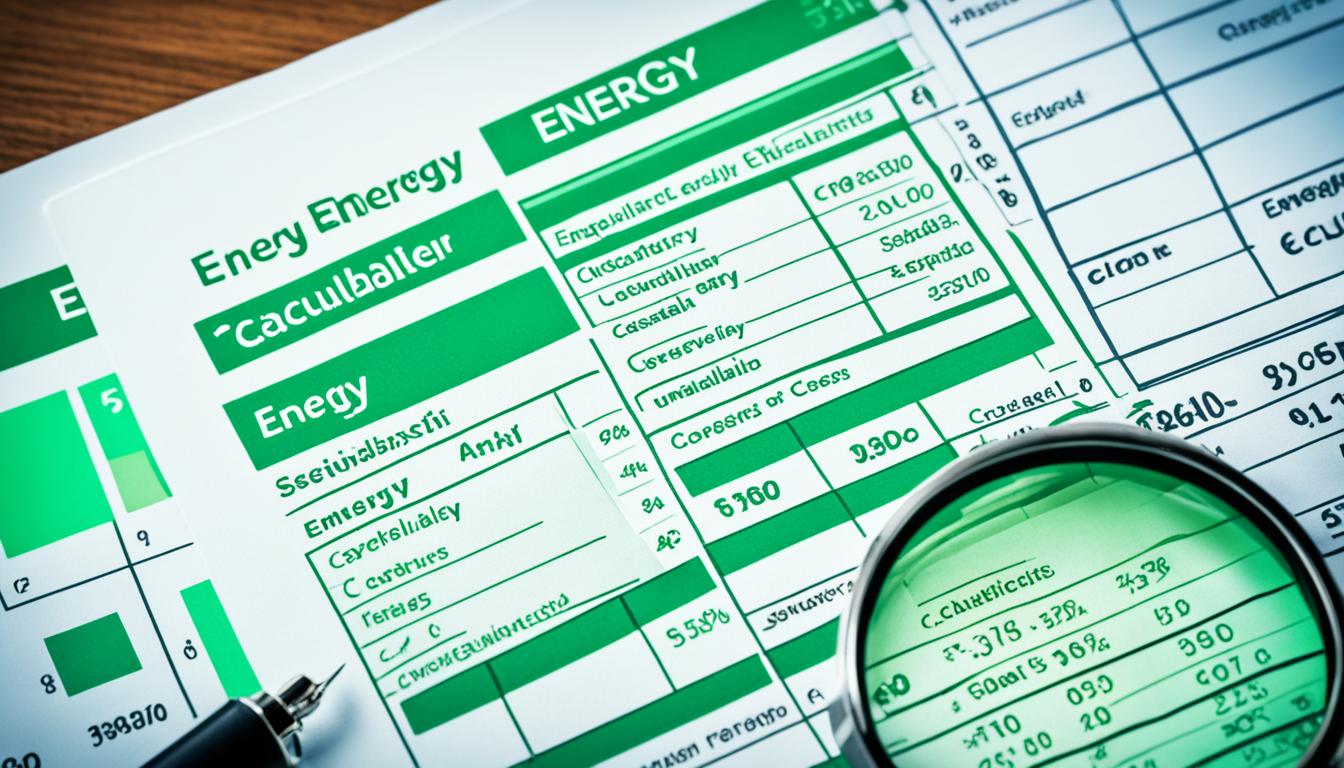Many businesses waste money on high energy consumption each year. By understanding and efficiently calculating your electricity costs, you can make simple changes to reduce energy usage and save on expenses. Use an electricity cost calculator to determine the impact of workplace changes on your monthly and yearly costs. Turning off appliances and devices when not in use, such as desktop computers and lights, can result in significant energy savings. Switching to more energy-efficient bulbs and using laptops instead of desktops can further reduce electricity expenses.
With the rising business electricity costs, it’s essential to have a clear understanding of where your expenses are coming from. Estimating the impact of certain energy-consuming factors can help your business identify areas for improvement and implement energy-saving measures. By utilizing an energy cost calculator, you can accurately calculate your electricity costs and identify potential savings.
Reducing your business electricity costs not only benefits your bottom line but also contributes to a more sustainable and environmentally-friendly practice. By making simple changes such as turning off devices when not in use and using energy-efficient lighting, you can make a significant impact on both your expenses and the environment.
Stay tuned for the upcoming sections, where we will dive deeper into specific aspects such as the impact of turning devices off, the cost of running desktop computers, the cost of lighting, and the energy savings of using laptops. We will also explore the benefits of switching business electricity suppliers and provide a comprehensive conclusion on how your business can effectively manage its electricity costs.
The Impact of Turning Devices Off When Not in Use
Businesses often underestimate the significant impact of turning devices off when they are not in use. One common example is leaving desktop computers on standby overnight, which can result in a substantial amount of wasted electricity over time. By properly estimating the costs of leaving computers and other devices on overnight using an electricity cost calculator, businesses can gain valuable insights into the potential energy and cost savings that can be redirected elsewhere.
Simple and mindful changes like implementing a policy to switch off appliances and devices during non-working hours can lead to considerable energy savings and significantly reduce electricity costs in the long run.
“Turning off devices when not in use is a straightforward yet effective way to reduce energy consumption and promote sustainability. It might seem like a small gesture, but the cumulative impact is substantial both in terms of energy savings and cost reduction.”
– Energy Efficiency Expert
Implementing practical strategies such as creating awareness and providing clear instructions to employees about turning off devices can lead to a positive shift in energy-saving behavior. Encouraging employees to be proactive in minimizing energy waste and emphasizing the benefits of energy-conscious practices can create a culture of energy efficiency within the workplace.
Visualizing the potential energy and cost savings can be a powerful motivator for businesses. Whether it’s presenting data in a visually engaging format or sharing success stories of other companies that have successfully reduced their energy consumption and achieved substantial electricity cost savings, businesses can inspire their employees to become active participants in the energy-saving journey.
Remember, every device that is turned off when not in use contributes to the collective effort of reducing energy consumption and improving sustainability. By taking small but impactful steps, businesses can make a significant difference, not only in terms of energy efficiency but also in terms of their bottom line.
The Potential Energy Savings
To illustrate the potential energy and cost savings of turning devices off when not in use, let’s consider the following scenario:
- An office with 50 desktop computers, each consuming an average of 200W per hour
- Devices are left on standby mode for 10 hours overnight
- The average energy consumption rate is £0.15 per kWh
Using an electricity cost calculator, we can estimate that by turning off those devices overnight, the business can potentially save:
| Number of Devices | Daily Energy Consumption | Daily Cost | Monthly Cost | Yearly Cost |
|---|---|---|---|---|
| 50 | 100 kWh | £15 | £450 | £5,400 |
By taking a proactive approach to turn off devices when not in use, this business has the potential to save £5,400 annually on electricity costs. These savings can be reinvested into other areas of the business or allocated towards sustainability initiatives.
As the saying goes, “Every little bit helps.” Together, our collective efforts in reducing energy consumption can make a substantial impact on the environment, while benefiting businesses through electricity cost savings and a positive brand image.

Take the initiative today and encourage your employees to switch off devices during non-working hours. Together, we can make a difference!
The Cost of Running Desktop Computers
When it comes to electricity costs in the workplace, desktop computers can make a significant contribution. It’s essential for businesses to understand the desktop computer energy consumption and electricity cost per computer in order to make informed decisions and potential energy savings. By utilizing an electricity cost calculator, businesses can estimate the annual expenses associated with running desktop computers.
Let’s consider a typical office scenario with ten desktop computers, each running for eight hours a day and turned off overnight. Using the electricity cost calculator, we can determine that the average annual cost per computer is £144.24, resulting in a total cost of £1,442.40 for all ten computers.
By turning off desktop computers overnight, businesses can avoid unnecessary consumption and save on electricity expenses.
What’s important to note is that if the computers are not entirely switched off overnight, they continue to consume electricity, leading to an additional 16 hours of unnecessary usage and higher costs. This further emphasizes the importance of powering down devices when not in use.
If your business is looking for even greater energy savings and reduced electricity expenses, an alternative solution is to consider using laptops instead of desktop computers. Laptops generally have lower energy consumption, resulting in cost savings over time.
Switching to laptops can contribute to energy savings and help reduce overall electricity costs in the workplace.

Using laptops not only reduces energy consumption but also offers increased mobility and flexibility for employees. By incorporating lightweight and energy-efficient laptops into your business operations, you can make a positive impact on both environmental sustainability and cost-effectiveness.
Energy Savings Comparison: Desktop Computers vs. Laptops
Let’s compare the average energy consumption of desktop computers and laptops:
| Device Type | Energy Consumption (Watts) |
|---|---|
| Desktop Computer | 250W |
| Laptop | 45W |
By considering the total energy consumption of using ten desktop computers running for 24 hours a day over a year, the estimated cost can reach £4,327.34. In comparison, using the same number of laptops for the same duration would only cost around £259.64.
Switching to laptops not only offers energy savings but also provides a more efficient and flexible work environment. Employees can easily carry their workstations with them, enabling productivity beyond the confines of the office space.
By prioritizing laptops over desktop computers, businesses can reduce energy consumption and achieve substantial cost savings.
In conclusion, understanding the cost implications of running desktop computers and exploring alternatives such as laptops can lead to significant energy savings and reduced electricity expenses for businesses. By leveraging an electricity cost calculator and making informed decisions about energy-efficient devices, businesses can contribute to a more sustainable and cost-effective work environment.
The Cost of Lighting
Did you know that lighting accounts for a significant portion of electricity consumption in UK office buildings? By understanding the lighting energy consumption of different types of light bulbs, businesses can make informed choices to reduce lighting costs and improve energy efficiency.
Replacing incandescent bulbs with energy-efficient bulbs such as LED bulbs can lead to substantial savings.
On average, a 60W incandescent bulb costs £34.62 to run for a year, while a 10W LED bulb costs only £5.77. That’s a significant difference in cost! By making the switch to LED bulbs, businesses can save money on both energy consumption and bulb replacements in the long run.
To determine the impact of lighting on your electricity costs, you can use an electricity cost calculator. This tool helps estimate the annual cost of lighting based on the number and wattage of bulbs used, giving you a clearer understanding of potential savings.
By investing in energy-efficient bulbs and optimizing lighting usage in your workspace, you can contribute to a greener environment and reduce your overhead expenses. Take a closer look at the lighting options available to your business and start making cost-effective choices today.
The Energy Savings of Using Laptops
Choosing laptops over desktop computers can lead to significant energy savings in the workplace. An average desktop computer consumes 250W, while an average laptop consumes only 45W. By using an electricity cost calculator, businesses can estimate the annual energy cost of using desktops versus laptops.
“Switching to laptops not only reduces energy consumption but also results in substantial cost savings.”
For example, ten desktop computers running for 24 hours a day for a year can cost £4,327.34, while the equivalent usage of ten laptops costs only £259.64. That’s a savings of £4,067.70! By opting for laptops, businesses can significantly reduce their energy consumption and lower their electricity expenses.

The Impact of Using Laptops on Energy Consumption
Using laptops instead of desktop computers provides several benefits in terms of energy consumption. The lower power consumption of laptops means they require less electricity to run, resulting in reduced energy usage and cost savings for businesses.
Furthermore, laptops are designed to be more energy-efficient, with features such as automatic power management and the ability to enter sleep mode when not in use. This functionality allows laptops to conserve energy and minimize wastage compared to desktop computers that remain powered on continuously.
Comparing Desktop Computers and Laptops
Let’s take a closer look at the energy consumption comparison between desktop computers and laptops:
| Device | Average Power Consumption (W) | Annual Energy Cost (based on 24 hours/day usage) |
|---|---|---|
| Desktop Computer | 250W | £4,327.34 |
| Laptop | 45W | £259.64 |
As shown in the table above, using laptops instead of desktop computers can result in significant energy savings and cost reductions. By making the switch, businesses can lower their environmental impact while maximizing their financial efficiency.
In addition to the energy savings, laptops offer the advantage of portability and flexibility. Employees can easily move around the office or work remotely, further enhancing productivity and collaboration.
It’s important for businesses to consider the long-term benefits of using laptops in terms of energy consumption and cost savings. By adopting more energy-efficient technology, businesses can contribute to a more sustainable future while achieving financial savings.
Business Electricity Consumption Chart
Business electricity consumption can vary depending on several factors, including the type of equipment used, the number of employees, and the efficiency of devices. While specific figures will differ from one business to another, there are average indicators for monthly usage and annual costs associated with different devices. By understanding these estimates, businesses can gain insight into their electricity consumption and plan for the corresponding expenses.
For instance, consider an office that utilizes a 250W desktop computer. On average, this setup may consume approximately 42 kWh per month. With this level of usage, the annual electricity cost for the desktop computer alone amounts to £144.24. Keep in mind that this is just one device and does not include other equipment or operational costs.
To gain a clearer understanding of the overall electricity expenditure, businesses can make use of electricity cost calculators. These tools enable businesses to estimate their monthly and yearly electricity costs based on the specific devices and their energy usage patterns. By inputting the relevant details, such as the number and wattage of devices used, businesses can obtain a more accurate estimate of their electricity expenses.
Understanding the business electricity consumption chart and estimating the associated costs allows organizations to better manage their energy consumption and allocate resources effectively. It also enables businesses to identify areas for potential energy savings and cost reduction. By optimizing energy usage and making informed decisions about equipment efficiency, businesses can lower their electricity expenses and improve their overall financial sustainability.
| Device | Average Monthly Usage (kWh) | Annual Electricity Costs (£) |
|---|---|---|
| Desktop Computer (250W) | 42 | 144.24 |
| Laptop (45W) | 7.5 | 25.56 |
| Fluorescent Light Bulb | 15 | 51.12 |
| Incandescent Light Bulb | 30 | 102.24 |
Note: The figures presented in the table are average estimates and may vary depending on various factors.
The Benefits of Switching Business Electricity Suppliers
Switching business electricity suppliers can result in significant cost savings for businesses. By comparing different electricity rates and suppliers, businesses can find the best prices and potentially reduce their energy expenses. Renewal rates for energy contracts are often higher than a supplier’s cheapest deal, so it’s important to compare prices before renewing a contract. Online tools like Business Electricity Prices provide instant quotes from a variety of electricity suppliers, making it easy for businesses to find the most affordable energy rates and save on their electricity costs.
When it comes to managing a business, every penny saved counts. With rising electricity costs, finding ways to cut down on energy expenses has become crucial. One effective strategy is to switch to a more cost-effective business electricity supplier.
“Switching business electricity suppliers can lead to substantial savings for businesses, allowing them to allocate these funds to other areas of their operations.”
By comparing different electricity rates and suppliers, businesses can take advantage of the competitive market to find the best prices. Renewal rates for energy contracts are often higher than a supplier’s cheapest deals, which is why it’s important to review options before committing to a new contract. Comparing prices can save businesses valuable resources and reduce their energy costs in the long run.
Business Electricity Prices is an online platform that offers a convenient way for businesses to compare electricity rates and suppliers. By simply entering their details, businesses can receive instant quotes from a variety of suppliers, ensuring they find the most affordable energy rates tailored to their needs.
The Benefits:
- Potential cost savings: Switching to a more cost-effective electricity supplier can result in significant cost savings for businesses, freeing up financial resources for other important initiatives.
- Easy comparison: Online platforms like Business Electricity Prices make it simple and hassle-free for businesses to compare electricity rates from multiple suppliers, saving them time and effort.
- Access to competitive rates: By exploring different suppliers, businesses have the opportunity to access competitive rates and secure the best deal for their energy needs.
- Flexible contract options: Switching suppliers provides businesses with the flexibility to choose contract terms that align with their requirements, allowing for better control over energy costs.
- Improved customer service: In addition to cost savings, switching suppliers can also lead to better customer service experiences, ensuring businesses receive the support they need.
In conclusion, switching business electricity suppliers is a proactive way for businesses to reduce their energy costs. By comparing rates and exploring options, businesses can find the most affordable energy rates and potentially save significant amounts of money. With online platforms like Business Electricity Prices, the process has become easier than ever, allowing businesses to make informed decisions and achieve energy cost savings without compromising the quality of their service.
Conclusion
Calculating and efficiently managing electricity costs is essential for businesses to streamline their finances. By using an electricity cost calculator and making simple changes such as turning off devices when not in use, switching to energy-efficient bulbs, and using laptops instead of desktops, businesses can significantly reduce their energy consumption and save on their electricity expenses.
Additionally, comparing electricity suppliers and finding the best rates can lead to further cost savings. By being proactive in managing electricity costs, businesses can improve their energy efficiency and allocate saved funds to other areas of their operations.
Take control of your energy cost savings and optimize your business electricity efficiency today. Start by calculating your electricity costs, implementing energy-saving measures, and exploring better electricity rates. By doing so, you not only reduce expenses but also contribute to a greener future.




